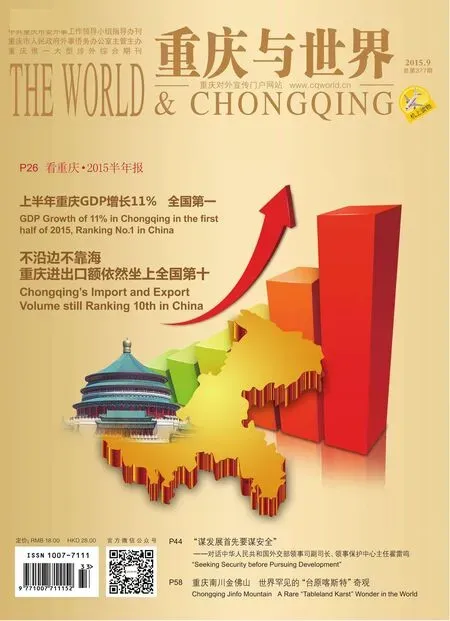到南川,看了喀斯特,还能游什么?
到南川,看了喀斯特,还能游什么?
南川区位于重庆市南部,地处渝黔、渝湘经济带交汇点。南川正努力创建国家级旅游度假区和中国旅游名城。
南川区旅游资源种类多、品位高、密度大、优势明显,现已建成金佛山—神龙峡景区、山王坪国家喀斯特生态公园、生态大观园、黎香湖湿地生态园、半溪河滨水公园等多处国家A级景区。

▲ 神龙峡漂流
神龙峡景区(国家AAAAA景区)
神龙峡景区地处金佛山以西,位于南川区南平镇内,是国家5A级旅游景区,其刺激的泉水漂流、秀美的湖光山色、湖边别墅木屋、美味的苗家美食成为市民不可不去的旅游目的地。
神龙峡景区距离重庆主城约85公里,距离南川城区27公里,幅员面积约13平方公里。神龙峡峡谷长,瀑布多,峡谷呈典型的“Y”字型形态,像一条横卧山涧的巨龙,因而得名神龙峡。沿大门进去,有一条长约4.2公里的养生步道,沿途可见“佛手印”“豹子岭”等峡谷奇观。每到雨后,峡谷内可见瀑布100处。神龙峡最高峰豹子岭海拔1380米,森林覆盖率达90%以上,年均温13.7℃,空气清新,雨量充沛,林深竹茂、流水飞瀑、峰峦绝壁、虫鸣鸟唱,是都市人休闲、避暑的绝佳场所。
神龙峡最惊险刺激的项目,是峡谷漂流,每到夏秋季节,每天前往神龙峡漂流的游客达数千人。神龙峡漂流全程约3公里,漂流河道位于峡谷石涧中,为木渡河的源头,泉水全部由地下水和林间山泉汇流而成。神龙峡漂流水质好、生态好,水温低、落差大、有惊无险,被誉为“天下第一漂”。
神龙峡飞索是今年新增加的游玩项目。飞索上站位于神龙洞洞口,下站位于山谷谷口水车处,全程滑行距离350米,高度60米,平均滑行速度8.158m/s。它能够让游客在观赏神龙溪的美景之余体会到凌空飞渡的新奇感受,既惊险刺激又安全可靠。
山王坪国家喀斯特生态公园
该公园主要包括山王坪景区生态石林在内的1.1万亩喀斯特地貌,拥有生态石林、溶洞、林海构成的自然生态景观。其中石林和溶洞属于典型的山原喀斯特地质地貌,是目前国内已探明面积最大、特色最显著的生态石林之一。南川山王坪还拥有5000亩水杉林、1000亩银杏林,是重庆最佳的云海日出观赏地。
主要景点1:生态石林
山王坪生态石林形成年代古老,生物资源丰富,规模庞大。石林与乔木、灌丛和绿苔融为一体,掩藏于遮天蔽日的原始林海中,还有千年红豆杉、红玉兰、金山山茶花和黄杨木等珍稀树种生长其中,是“生态石林”“绿色石林”的代表。“树抱石”“石抱树”成为了生态石林的特色奇观,是全国植被发育和保存最好的生态石林,石林与各种形态各异、造型奇特的各种树木、藤蔓丛生,构成了一幅幅天然的盆景。
主要景点2:水杉林
5000亩的水杉林,从公园入口一直到山王坪石林景区,顺着公路,两旁都是水杉林,形成风光旖旎的行道树。告别喧嚣的城市,来到这僻静的水杉林,漫步林间小道,踏着松软的泥土,听鸟鸣虫嘶,看栖禽相戏,闻草木芬芳,享受返璞归真的境界。山王坪植被丰富,怪石遍布,林荫小道弯弯曲曲,保留着极浓的原始气息。这里地势海拔高,夏季平均气温23℃左右,是避暑度假胜地。
秋到山王坪,就象斜阳穿过姑娘的发丝,用金色浸染了银杏、红枫,将世界变成了彩色,红透了漫山的水杉林,等你走来,静静地欣赏,把那一抹余晖透进眼底,留在心中。

▲ 山王坪5000亩人工水杉林海已经成为一道美丽风景

▲ 生态石林
重庆生态大观园
生态农业大观园地处南川区西北部,是重庆市唯一的省级生态农业示范区,涵盖大观镇、兴隆镇、土溪乡、河图乡和木凉乡。示范区区位优势明显,交通便捷,渝湘高速贯穿全境,到重庆江北机场、保税港区、物流中心均在1小时以内。
重庆生态大观园内有樱花大道、香草园、玫瑰园、猕猴桃园、蓝莓园、荷花园、葡萄园、珍奇瓜果园、金佛山珍稀植物园等,一年四季,美景、美食丰富多彩,赏花、采摘、垂钓、品尝、农事体验等活动连续不断,是重庆大都市边最大最美的乡村田园。
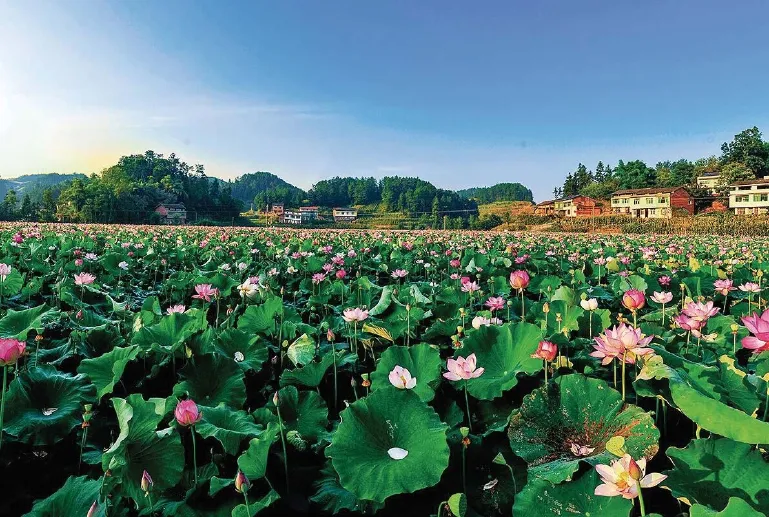
▲ 大观园荷花
黎香湖国家湿地生态园
黎香湖地处南川北部生态农业园区腹心地带,距重庆主城59公里(高速),南川城区28公里(高速),经渝湘高速大观下匝道即可直达。黎香湖山清水秀,清澈幽静,港湾众多,驳岸线曲折环绕(全长65公里),气候宜人,是生态旅游、休闲度假,健体养身的理想之地。
黎香湖是上帝遗留人世间的一滴眼泪,清澈剔透,碧波荡漾,阳光照在波光粼粼的湖面上,像是铺上了一层闪闪发光的碎银,又像被揉皱了的绿缎。周边建有独具欧派风味的瑞士风情小镇,连排别墅与碧蓝的湖水相互映衬,荡着一艘轻舟使人似乎感觉不出谁是天,谁是湖,其800米的最佳海拔高度更是休闲度假的绝佳地,如果你想体验一场西式的浪漫婚礼,带上心爱的她来这儿吧。

▲ 瑞士风情小镇
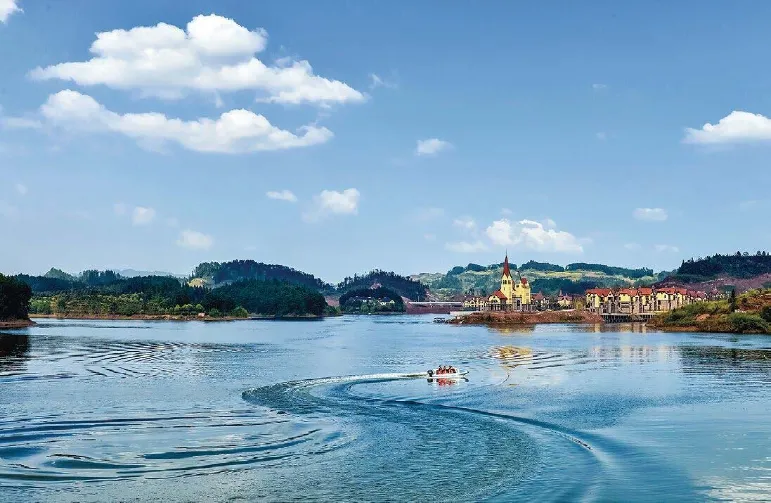
▲ 黎香湖
178km金佛山环山趣驾
今年夏天,我们为广大市民朋友量身定做了6条自驾纳凉避暑精品线路,其中,金佛山环山趣驾全长达178千米,可尝试一日游、二日游、三日游等多种趣驾策略,“转山转水转金佛,时来运转”,来金佛山自驾,沿途原始自然景观和乡村人文风情具有无限魅力。
经勘测,南川为富硒土壤区,硒含量大于0.3mg的富硒土壤达780平方公里,集中分布在金佛山环线、大观园环线区域,这些地方生长的富硒果蔬有提高人体免疫力、延缓衰老、防癌抗癌、保护眼睛、保护肝脏、防治心脑血管疾病等攻效,金佛山方竹笋、高山果蔬、土鸡土鸭、小河米粉等地方特色产品,是自驾出游充实后备箱的理想选择。
南川还有五百多家设施完善、服务一流的农家乐,自驾车友可通过查阅《自驾南川全攻略》便可了解沿途吃、住、玩等相关信息,沿途设置的30余家自驾游服务站,可以为车友提供加水、公厕、咨询等服务;露营基地十六个,星空露营、临崖露营、森林露营,各种形式应有尽有。车友自驾游南川,欣赏自然美景,体验人文风情,在野外露营避暑,将会成为这个夏天最难忘的体验。

▲ 东坡望星空
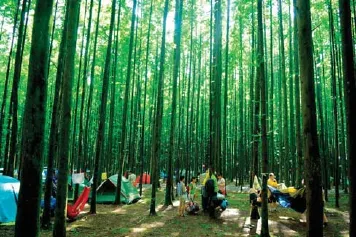
▲ 山王坪露营

▲ 绝壁栈道

Jinfo Mountain
Chongqing Nanchuan Jinfo Mountain is situated in the northernmost of Dalou mountain range, whose major peak Fengchui ridge, the highest mountain of the Dalou range, has an altitude as much as 2238 meters. With coverage of 1,300 square kilometers, it becomes a maximum-sized, second-tonone natural air conditioner and forest oxygen bar nearest to the downtown Chongqing. On June 23, 2014, the 38th session of the World Heritage Committee voted for and passed the “South China Karst” application project including Jinfo Mountain; since then, Jinfo Mountain has been listed as one in the World Natural Heritage.
Before that, Jinfo Mountain has been endowed with a multitude of “National titles” such as the National Scenic Area,National Forest Park, the First National Science Education Base, National Nature Reserves, National Natural Heritage and National 5A Tourist Attractions, to cite but a few.
Jinfo tour can keep the travelers access to three wonders: World Natural Karst Heritage, biodiversity and Buddhist culture.
World Natural Heritage—the unique landscape of Karst tableland has formed a grand magnificent landscape spectacle in Jinfo. “How precipitous Jinfo is that it is towering between misty clouds” is the best portrayal of Jinfo Mountain. As an example of world Tableland landscape, Jinfo's worldlevel square-shaped table topography is surrounded by steep giant cliffs, in which the mountain caves served as basis are embedded. Together, these giant cliffs and caves present a spectacular combination of scenic landform. Since Jinfo has recorded the cutting process of the high- altitude karst plateau, and it also contains evidence of intermittent uplifts and karstification of the region since the Cenozoic, it is the most typical tableland karst area.
Walking along the green ponds and deep valley, up to the mountain top by the most beautiful trail, or taking the westernslope cableway famous for its maximum elevation of Asia, one can witness the lofty manner of the above-cloud Jinfo. Beneath the ridge “Tortoise Facing Sun” is a footpath of a total length of 3,500 meters on a steep cliff, both thrilling and breath-taking. In the body of the Jinfo Mountain is tucked with an ancient Buddhist cave known as “the top Buddhist cave”, which is the world's oldest and highest cave with a probe length over 25 km. Inside the cave a 10,000 square-meter underground hall could be viewed with the attractions like “Buddha landing from the heaven”, and the Arhat group.
Jinfo enjoys a 1900-meter altitude gap which makes it a majestic mountain with running ridges and ever-changing weather and views. In scorching summer days, the average temperature is 21.7 degrees Celsius in Jinfo Mountain, rich in negative oxygen ions, whose green sites, meandering streams,and refreshing air has made the place an attractive summer resort. Every winter, the mountain is clad in silvery white snow. As the most lasting and best-equipped southern snowfield in Chongqing, it offers visitors with superb experiences to see the snow, play the snow, and skiing.
Living up to its reputation as a “biological gene bank”,its identified plant resources have reached 5907 kinds, 1607 genera under 302 families, animal resources 1762 kinds under 324 families, of which, 16 kinds of the plants have been listed as the f rst-rating national protective plants. Among “The Wonderful Fives” (Silver f r, Chimonobambusa qundrangularis,azalea, Gingko, big-tree tea), silver f r is known as the “living fossil plant”, “panda in the plant”. Jinfo Mountain is endowed with 1978silver f rs, a wonder of the world's rare plants. Every April and May, the mountain is embellished with 500 000(49 kinds) alpineazalea trees, whose petals in full blossom,colors bright and permeating, and clusters of f owers forming a magnif cent spectacle. Chimonobambusa is a unique plant; with a seemingly rounded f gure, it feels edges and corners. After the annual autumn rain, countless fresh bamboo shoots sprout in the 100,000 acres of bamboo forest, which is renowned as the Mountain Treasure for its tender texture and f ne taste.
Jinfo is the world's only mountain named after the “Golden Buddha” (Jinfo). The summer and autumn sunny evening would behold that the layers of the cliff is dyed by the sunset oblique,shining resplendently like a gilded Buddha statue; that's why the famous Chinese cultural scholar Yu Qiuyu accredits Jinfo as “mountain and Buddha live in one.” Ever since the Tang Dynasty, Jinfo has enshrined and worshiped the Dipamkara as a famous Buddha temple. Up to Ming and Qing dynasties,Buddhism of the mountain entered its heyday, with famous temples up to 300; therefore, Jinfo is known as “Southern Top Buddhism Site, Bashu First Famous Mountain” and taking its rank in “Emei, the north, south Jinfo, Putuo east, and towards the west the Golden Buddha”. Today, the Golden Buddha Temple on Jinfo invites many devout pilgrims; a prosperous site of worshiping for Buddhists, it is the largest Buddhist shrine in Sichuan-Chongqing-Guizhou area.
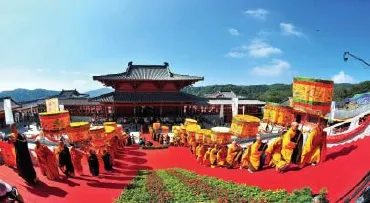
▲ The Golden Buddha Temple

▲ The Western-Slope Cableway
Since 1985, China has accessed into the "World Cultural and Natural Heritage Protection Convention"; till June 23,2014, there are all over 47 World Heritage Sites listed in China,including 33 cultural heritages, 10 natural ones, 4 culturalnatural ones.
"Karst" was originally a limestone plateau in northwestern Yugoslavia, a natural phenomenon of mechanical erosion and chemical corrosion by water on certain rocks. South China Karst geomorphology starts from the Himalayas range;from west to east they are respectively Tibetan karst plateau glaciers, periglacial Karst, in South China the Karst takes shape ranging from the sword-shaped karst (Stone Forest), tableland karst (Jinfo mountain), karst valleys (Wulong), calcified Karst(Jiuzhaigou), dolomite karst (Shi Bing), cone karst plateau slope(Libo-Huan Jiang), plain tower karst (Guilin), to the Vietnam Halong Bay coastal peak forest Karst landscape. Among them, the Yunnan Stone Forest, Libo in Guizhou, and Wulong were taken as “South China Karst” (f rst phase) World Natural Heritage nomination, which have been off cially listed as World Natural Heritage Site on June 27, 2007.
“South China Karst” (Phase II) World Natural Heritage includes three nominations -- Jinfo Karst tableland, Guilin continental tower karst, Guizhou Shibing dolomite karst, and Libo expansion area Huanjiang.
Chongqing Jinfo Karst is seated in Nanchuan District,located in the transitional zone of Yunnan-Guizhou Plateau edge to the Sichuan Basin. As a typical representative of the cutting plateau Karst Tableland, it is the remaining part of the ancient planation surface. Its topography is characterized with a high-altitude cave system, multi-level planation surfaces,recovered peak clusters and low-lying lands, closed cliffs, deep canyons and other morphological features. The total area of Jinfo Karst is174.19 square kilometers, the core area of 67.44 square kilometers of which is bordered by f rst-level cliffs, the rest 106.75 square-kilometer buffer area is bordered by the second level cliffs .
Jinfo Mountain is constituted by two karst systems -the underground cave systems and modern shallow surface karst system; with antiquity, inheritance, multiple generations and continuity, it represents the ancient process history of Yunnan-Guizhou Plateau edge geological landforms, and it also provides an ideal place for the study on the evolution andits properties of the Yunnan-Guizhou plateau karst area since the Cenozoic.
Jinfo Karst has met the dual criteria—World Heritage criteria Ⅶ andⅧ: First, the unusual natural phenomena and the exceptional aesthetic value, the second is an important component of the Southern China Karst evolution.
Jinfo Mountain is bequeathed with 5unique karst Humanities wonders of nature: a typical Karst tableland,ancient high-altitude cave system,colorful surface karst landscapes, rich biodiversity and long nitrate-instilling history and culture, which served as a dynamo for the successful application.
First, Jinfo Karst tableland is of spectacular form; with its cliffs completely closed, it is not only unique in southern China, but also a model of the world karst Tableland.
Second, the huge and ancient highaltitude underground cave system of Jinfo Mountain is with clear development levels, which reflects the significant changes of the hydrogeological and ancient karst geomorphological evolution in Jinfo mountainous area.
Third, Jinfo'srich surface karst landscape has formed erosion hills, lowlying lands, slockers, Stone Forests,waterfalls, canyons, hanging valleys, and other natural astronomical landscape with extraordinary natural beauty like snow and ice, rime, clouds, sunrise,f ammule.
Fourth, Jinfo Mountain, as a rare biological gene bank in southwest China, is one of the most biodiverse regions at the same latitude karst areas,whose endangered, endemic, rare f ora and fauna spawn a unique landscape biodiversity.
Fifth, in addition to the above four unique cultural spectacles, the long history and culture of its nitrate-instilling can be traced back to 700 years ago,of where the glorious history of the development of Chinese gunpowder was witnessed.
Jinfo World Heritage Application Time Nubs
In 1998 and 2003, Jinfo Mountain has twice been included in the World Natural Heritage Tentative List.
On June 3, 2012, the official launch of the Jinfo “South China Karst” world heritage application project.
From August 20 to September 1, 2013, the International Union for Conservation of Nature and Natural Resources (abbreviation: IUCN) expert paid f eld visits to assess the “South China Karst” application sites.
On June 23, 2014, the 38th session of the World Heritage Committee voted by ballot for the “South China Karst” project, when Jinfo was put on the World Natural Heritage Site list.
Experts' Comments
· Internationally renowned karst expert and professor of the Royal Canadian Academy of Sciences Rick Ford: Jinfo plateau evolution and Karst tableland development is unique. The latter part of it is irreplaceable in the South China Karst Heritage Project; and what makes it more valuable is that its resources have not been artificially demolished,and the integrity is effectively protected.
· Former chairman of the International Association of Cave, Andrew Evans: Jinfo nitrate-instilling underground plant has made a rarity of the world.
· Professor Smith, Chairman of the Task Force on Caves and Karst of the World Heritage Protection Alliance: Jinfo Karst geological features are prominent. It's been long since its very formation; with a large scale, and such a wealth of biological resources in the karst area, it is very representative.
· Internationally renowned Karst expert,Professor Paul Williams of Auckland University in New Zealand: Jinfo cave system ref ects the evolution of the Earth and the history of landscape changes,forest systems reflecting the evolution of karst ecosystems. There is no doubt that Jinfo is rich with the world's natural heritage value. Jinfo nitrate-mining ruins,of great cultural value, have provided important evidence to the gunpowder manufacturing, one of the four Chinese inventions.
· Academician of the Chinese Academy of Sciences, Yuan Taoxian: the highaltitude Jinfo Karst tableland is short of water conditions, so how were they formed the massive underground cave system and large accumulation of cave gravel layer? The problem got no answers from the three other South China Karst nominations, which makes it a must of Jinfo Mountain in the project.
· Chinese Academy of Sciences academician, taxonomic expert Wang Wencai: Jinfo has rich f ora.
· Institute of Karst Geology, Chinese Academy of Geological Sciences researcher Zhu Xuewen: Jinfo Mountain enjoys obvious advantages in its biological resources, karst topography,geological structure, evolution history that few international and domestic places can keep on the par with.
Nanchuan District, in the south of Chongqing municipality, is located in where Yuqian(Chongqing and Guizhou Province) economic belt and Chongqing-Hunan (Chongqing-Hunan Province) economic belt meet. It is making efforts to create a national tourist resort and a famous tourist city of China.
The tourism resources in Nanchuan District are of great variety, high grade, high density and obvious advantages. Now, Jinfo Mountain & the Dragon Gorge scenic spot,Shanwangping National Karst Ecological Park, Nanchuan Ecological Gand View Garden,Lixiang Lake Wetland Ecological Park, Banxi Riverside Park and many other A-level national scenic resorts have been built here. More detailed information about these scenic spots will be introduced respectively as follows:
The Dragon Gorge Scenic Resort (National 5A-level Scenic Area)

▲ The Dragon Gorge Drift
The Dragon Gorge scenic resort is located in the west of Jinfo Mountain in Nanping town, Nanchuan District. As a national 5A-level scenic spot, its thrilling spring water rafting, beautiful landscape of lakes and mountains, wooden houses and villas beside lakes, and delicious Miao food are so attractive to tourists that the resort becomes a popular destination.
It is about 85 kilometers away from the Dragon Gorge scenic spot to the main urban region of Chongqing and 27 kilometers to Nanchuan city. The area of the Dragon Gorge scenic spot is about 13 square kilometers. With long gorges and numerous waterfalls, the Dragon Gorge takes on the typical shape of Y, like a recumbent dragon in a mountain,hence the name of it. Walk across the entrance of the resort and a 4.2-kilometers footpath along with “Buddha's Hand Print”, “Leopard Ridge” and many other natural valley wonders will jump into your sight. About 100 waterfalls will appear in the canyon every time rain stops. The highest peak of the mountains in the Dragon Gorge-Leopard Ridge-is 1380 meters above the sea level. With a forest coverage rate of over 90%,average annual temperature of 13.7 degrees centigrade, fresh air, abundant rain, flouring plants, waterfalls, steep cliffs and happy birds, the Dragon Gorge is one of the best resorts for urban citizens to take holidays leisurely in hot summer.
The most thrilling activity in the Dragon Gorge scenic spot is canyon raft ride. Several thousand visitors come to play this activity every day in summer. The whole journey with a raft ride track in the middle of canyons is about 3 kilometers. Water in the gorges f ows from underground and springs in mountains and the source is Mudu River. The Dragon Gorge raft ride is praised as the First Raft Ride in the World for high water quality, good ecological environment, low water temperature and constant water flow which bring only excitement without danger.
Water cableway, the newly built water sports equipment,is about 350 meters in length and 60 meters in height. The upstream stop is built at the entrance to the Dragon Cave and the downstream stop beside the waterwheel at the exit of a valley. Its average sliding speed is at 8.158 meters per second so that the visitors can enjoy the excitement as if f oating in the sky and at the same time appreciate the splendid views around the Dragon River. The water cableway is really safe, reliable and thrilling.
Shanwangping National Karst Ecological Park
This park covers an area of 11,000 mu (about 733 hectares) of karst landscape with ecological stone forest, karst caves and immense forests, of which stone forest and karst caves are of typical plateau karst landscapes. Shanwangping ecological stone forest is one of the most distinctive and vastest ones ever explored in China. In addition, there are 5,000 mu(equals 333.33hectares) of metasequoia and 1,000 mu (about 66.67 hectares) of ginkgo growing here and Shanwangping is the best place to view the clouds and sunrise in Chongqing.
Main Attraction 1: Ecological Stone Forest
The large-scale Shanwangping ecological stone forest is formed in the ancient times and therefore has abundant biological resources. Stone forests, arbors, bush woods and green mosses combined with Chinese yew, red magnolia,camellia, boxwood and other rare trees are covered in the primeval forests. Therefore, Shanwangping ecological stone forest is a good example of ecological stone forest and green stone forest. Flouring trees surrounding stones and stones encircling trees form a unique landscape of stone forest. As one of the best conserved stone forests with best vegetation growing in China, Shanwangping ecological stone forest presents a picture of natural bonsai.
Main Attraction 2: Metasequoia Woods
Along the entrance to the park to Shanwangping stone forest scenic spot, 5,000 mu (equals 333.33hectares) of metasequoia stands on each side of the road. Leave the hustle and bustle of the city for the secular metasequoia woods, and you can take a leisure walk on the paths, listen to the happy birds singing, watch the insects sporting and smell the fragrant flowers and grasses. What a pleasant experience as if you return to the true nature! The rich plants, all-shaped stones and winding tree-lined paths here all contribute to its primeval beauty of Shanwangping. With a high altitude and average temperature of 23 degrees in summer, it is a good place to take summer holidays.
In autumn, ginkgoes and red maples paint the world colorful with the golden hair of a girl that has been soaked by the setting sun. The completely red metasequoia woods wait for you to come near and have a good look, leaving the last ray of sunset in your eyes and your peaceful heart.

▲ Shanwangping 5000-mu artificial metasequoia forest delivers gorgeous sights

▲ The Ecological Stone Forest
Nanchuan Ecological Grand View Garden
As the only one national modern agriculture demonstration zone in Chongqing, the Ecological Grand View Garden is situated in the northwest of Nanchuan, covering Daguan Town, Xinlong Town, Lixiang Town, Muliang Village and Hetu Village. The demonstration zone is in a favorable geographic position where the transportation is convenient with Chongqing-Hunan Highway through the whole territory. It is within one hour distance to Chongqing Jiangbei Airport, Chongqing bonded port and logistics centers.
As the biggest and most beautiful rural garden in the countryside of Chongqing,the Ecological Grand View Garden has cheery avenue, herb garden, rose garden,kiwi garden, blueberry garden, lotus pool,vineyard, exotic fruit garden and botanic garden with rare Jinfo Mountain plants. Throughout the year, different varieties of activities such as picking f owers and fruits,fishing, tasting cuisine and farming are carried out here.
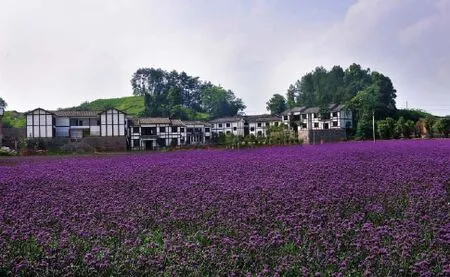
▲ Herb Garden

▲ Lotus in Grand View Garden

▲ The Swiss-Style Town
Lixiang Lake Wetland Ecological Park
Lixiang Lake Wetland Ecological Park is situated in the hinterland of Nanchuan northern ecological agriculture park, 59 kilometers (highway) away from the main region of Chongqing and 28 kilometers away from Nanchuan city. Drive off Chongqing—Hunan highway and notice the downward lane,and you can arrive there directly. Surrounded by 65-kilometer revetment line,Lixiang Lake has many harbors. It is such an ideal and comfortable place that visitors can take holidays, build f tness and nourish their souls, for the water is clear, the mountain beautiful and the environment peaceful.
Lixiang Lake is a drop of water left by God on the earth, clear and transparent. The rippling waves in the lake spark like a layer of shiny silver and are crumpled like a piece of green satin. A Swiss-style town with European flavor is surrounded the lake. The villas are against the clear water, making you diff cult to distinguish the lake from the sky. If you want to experience a western-style wedding, come here with your beloved.

▲ Lixiang Lake
178 kilometers driving around Jinfo Mountain
Nanchuan district has tailored 6 optional self-driving routes for visitors this summer, of which the Jinfo Mountain driving route is 178 kilometers and you can try one-day tour, two-day tour or three-day tour. As a saying goes, “Walk around waters and Jinfo Mountain, good luck will comes to you.” Driving for a trip in Jinfo Mountain, you can enjoy the beautiful natural scenery and the charm of rural cultural customs along the road.
The soil in Nanchuan is rich in selenium according to the exploration. The land contains mora than 0.3mg selenium ( per kilogram soil) covering an area of 780 square kilometers, mainly including Jinfo Mountain and Grand View Garden districts. Se-rich fruits and vegetables grown in these places can improve immunity and have the effects of anti-aging, anticancer, eye and liver protection, prevention and treatment of cardiovascular and cerebrovascular diseases. The local specialty products, such as Jinfo Mountain bamboo shoots, Gaoshan Mountain fruits and vegetables, local chickens and ducks and Xiaohe rice noodles, are all ideal choices for selfdriving tour.
There are more than 500 rural home inns with well-equipped facilities and first-class service. In A Guide to Nanchuan Traveling for Drivers, car-driving visitors can search for more information about food,accommodation and entertainments. Over 30 car service stations along the road can provide you with water, rest room and consultation services. There are 16 camp sites with a large variety of camp choices such as camp in starry nights, camp beside cliffs, and camp in forest and so on. In Nanchuan, you can enjoy the beautiful scenery, the local cultural customs and the delight of camping in the open air. It will be a pleasant and unforgettable experience for visitors to take holidays here.
Chongqing Jinfo Mountain A Rare“Tableland Karst” Wonder in the World
□ Written and Edited by Tang Gang
Why Jinfo deserves to be placed in the Heritage list?
More Tourist Attractions besides Karst Landscapes in Nanchuan

▲ The Starry Sky viewed at the Eastern Slope
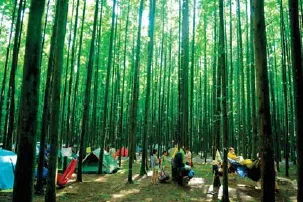
▲ Shanwangping Camping

▲ The Walkway along the cliff
——重庆山水都市旅游

